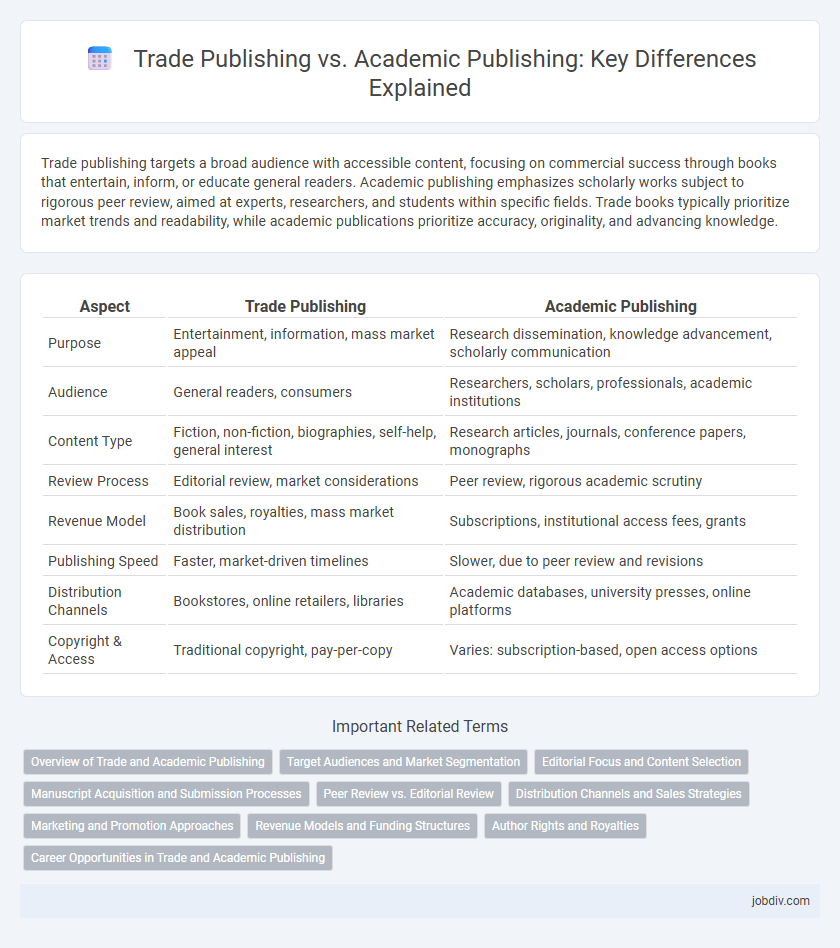Trade publishing targets a broad audience with accessible content, focusing on commercial success through books that entertain, inform, or educate general readers. Academic publishing emphasizes scholarly works subject to rigorous peer review, aimed at experts, researchers, and students within specific fields. Trade books typically prioritize market trends and readability, while academic publications prioritize accuracy, originality, and advancing knowledge.
Table of Comparison
| Aspect | Trade Publishing | Academic Publishing |
|---|---|---|
| Purpose | Entertainment, information, mass market appeal | Research dissemination, knowledge advancement, scholarly communication |
| Audience | General readers, consumers | Researchers, scholars, professionals, academic institutions |
| Content Type | Fiction, non-fiction, biographies, self-help, general interest | Research articles, journals, conference papers, monographs |
| Review Process | Editorial review, market considerations | Peer review, rigorous academic scrutiny |
| Revenue Model | Book sales, royalties, mass market distribution | Subscriptions, institutional access fees, grants |
| Publishing Speed | Faster, market-driven timelines | Slower, due to peer review and revisions |
| Distribution Channels | Bookstores, online retailers, libraries | Academic databases, university presses, online platforms |
| Copyright & Access | Traditional copyright, pay-per-copy | Varies: subscription-based, open access options |
Overview of Trade and Academic Publishing
Trade publishing targets a broad general audience with commercial books in genres such as fiction, non-fiction, and lifestyle, emphasizing market trends and bestseller potential. Academic publishing focuses on scholarly works including research journals, monographs, and textbooks, prioritizing peer review and subject-specific rigor. Both sectors utilize distinct editorial processes and distribution channels to meet the needs of their respective readerships and market demands.
Target Audiences and Market Segmentation
Trade publishing primarily targets general consumers with interests in fiction, non-fiction, and popular culture, emphasizing broad market appeal and reader accessibility. Academic publishing caters to scholars, researchers, and professionals within specific disciplines, focusing on specialized content and niche markets. Market segmentation in trade publishing relies on demographic and psychographic factors, while academic publishing segments based on subject area expertise and institutional affiliations.
Editorial Focus and Content Selection
Trade publishing prioritizes market-driven content with a strong emphasis on storytelling, entertainment, and broad audience appeal, selecting manuscripts based on commercial potential and current trends. Academic publishing centers on rigorous peer-reviewed research, valuing originality, methodology, and contribution to scholarly knowledge within specific disciplines. Editorial focus in trade publishing aims to captivate general readers, while academic publishing underscores accuracy, credibility, and advancement of academic fields.
Manuscript Acquisition and Submission Processes
Trade publishing primarily relies on agent submissions and unsolicited manuscripts, emphasizing marketability and broad audience appeal during manuscript acquisition. Academic publishing requires rigorous peer review processes with direct submissions from researchers or scholars, focusing on originality and scholarly contribution. Manuscript acquisition in academic publishing often involves detailed guidelines and ethical compliance, contrasting with the more flexible, trend-driven approach in trade publishing.
Peer Review vs. Editorial Review
Trade publishing primarily relies on editorial review, where experienced editors assess manuscripts for market appeal, readability, and commercial potential without a formal peer review process. In contrast, academic publishing mandates a rigorous peer review system, engaging experts in the field to evaluate the validity, methodology, and contribution of research before publication. The distinct review processes reflect the differing goals: trade publishing targets general audiences with accessible content, while academic publishing ensures scholarly rigor and credibility.
Distribution Channels and Sales Strategies
Trade publishing primarily utilizes mass-market bookstores, online retailers like Amazon, and large-scale distributors to reach a broad, consumer-focused audience, emphasizing high-volume sales and marketing campaigns. Academic publishing relies heavily on specialized distribution channels such as institutional subscriptions, academic libraries, and digital platforms like JSTOR or ScienceDirect, targeting researchers and educational institutions with a focus on credibility and niche market penetration. Sales strategies in trade publishing often involve author tours, media promotions, and bestseller lists, whereas academic publishing emphasizes peer-reviewed content, conference showcases, and partnerships with universities and scholarly societies.
Marketing and Promotion Approaches
Trade publishing employs broad marketing strategies targeting mass audiences through social media campaigns, book tours, and media appearances to maximize visibility and sales. Academic publishing relies on niche promotion, focusing on conferences, scholarly journals, and university networks to reach specialized readers and institutional buyers. Both sectors utilize digital platforms, but trade publishing emphasizes consumer engagement while academic publishing prioritizes peer recognition and citation impact.
Revenue Models and Funding Structures
Trade publishing primarily relies on revenue from book sales, including print, digital, and audiobook formats, with funding sourced from advance payments by publishers and royalties paid to authors. Academic publishing generates income through subscription fees, institutional library access, and article processing charges (APCs), often supported by grants, university funding, or governmental research budgets. The funding structure of academic publishing emphasizes open access mandates and paywalls, contrasting with trade publishing's market-driven sales model.
Author Rights and Royalties
Trade publishing offers authors broader rights retention and potentially higher royalty percentages, typically ranging from 10% to 15% of net sales, reflecting commercial market dynamics. Academic publishing often requires authors to transfer extensive rights to publishers, resulting in lower or no royalties, as content is primarily disseminated through institutional subscriptions and licensing. Understanding these differences is crucial for authors negotiating contracts to maximize control and income from their work.
Career Opportunities in Trade and Academic Publishing
Trade publishing offers diverse career opportunities in editorial, marketing, and sales roles focusing on fiction, non-fiction, and popular genres for broad audiences. Academic publishing careers specialize in managing peer-reviewed journals, scholarly books, and research dissemination, requiring expertise in specific academic fields and compliance with publishing ethics. Both sectors demand strong project management, digital literacy, and communication skills, but academic publishing often emphasizes scientific knowledge and collaboration with researchers.
Trade Publishing vs Academic Publishing Infographic

 jobdiv.com
jobdiv.com